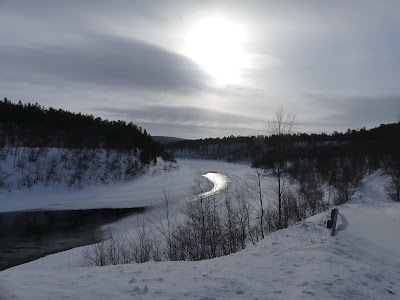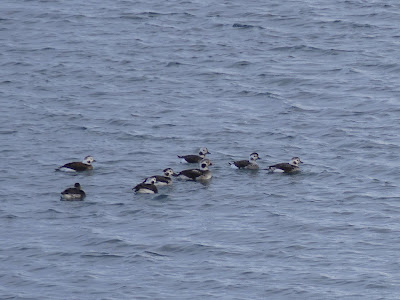It’s not often we do something spontaneous, and
a week away booked a fortnight in advance is
just about as spontaneous as we are ever likely to get. Our destination was
Finland. We started with a flight from Heathrow to Helsinki, transferring on to
Ivalo in the north. Chris had done plenty of research to find lodges with
feeders and had also been in contact with a Finnish ringer that we met while in
Georgia.
After a drive of an hour or so on snow and ice covered roads
we reached our first overnight stop Neljän Tuulen Tupa, Kaamanen.
14th March
A quaint awakening as the squirrels skittering about beat
the alarm to waking us. We were out before breakfast, trying to photograph the
speciality species that we’d come to see. Siberian Tit, Siberian Jay and Pine
Grosbeak were all most obliging.
Siberian Jay
Siberian Tit
Pine Grosbeak, male
Red Squirrel
Siberian Tit
Pine Grosbeak female
We enjoyed a lengthy breakfast, still watching the activity
at the feeders, then after a final try for a last few photos set out for Vadsø.
Bird sightings for the morning, Pine Grosbeak (many), Siberian Tit ( up to 3 at
one time), Siberian Jay (up to 3 at once), Arctic Redpoll (1), Willow Tit (2),
Great Tit (few), Blue Tit (1), Greenfinch (2), Bullfinch (1), Hooded Crow (2),
Magpie (3).
Finland is 75% forest with only 5.5 million inhabitants. Most of the
population lives to the south of the country. This year the snow came very late, so late as to create a lot of problems in Lapland in that there was less snow and skiing and ski-doo activities were affected. When the snow came late, there was more than usual.
Roads were completely snow covered, often with snow banked up along the edges.
Speed limits were usually 80 to 100 km per hour - no problem with snow tyres. Worse thing was not being able to pull off the road unless there was a cleared lay-by.
There wasn’t much wildlife along the way, but
we did find our first Reindeer. Birds included Willow Ptarmigan (8 on the
road) in Finland.
After crossing into Norway we saw a first year Golden Eagle.
We kept looking for Hawk Owl but had no luck. On reaching Varanger Fjord we
stopped off at Nesseby, seeing our first large numbers of Purple Sandpiper,
Red-breasted Mergansers (c50), Common Eider (20), King Eider (8) also
Kittiwakes and Ravens.
The church at Nesseby
Vadsø
At
Vadsø there were more eiders on the fjord
including some Steller’s Eider (16) feeding close to our hotel , King Eider
(27), Long-tailed Duck (25), Common Eider and a lot of Purple Sandpiper.
Long-tailed Duck
Steller's Eider
Purple Sandpipers
15th March
Snowshoe hare in the blue light of morning.
Having failed to get the faintest chance at the Northern
Lights due to heavy cloud, it was nice to start the day with Snowshoe Hare seen
just a few metres from our bedroom window. The day was earmarked for a drive to
Vardø. As we drove on the landscape became more open, sometimes with rocky
outcrops, all coated in thick snow.
Varanger Fjord
The inland section of the fjord was frozen, as were small bays and inlets along the route to Vardø.
Glaucous Gull
Nesting Kittiwakes at Vardø by the harbour.
The church at Vardø
View of Vardø
In
the havn there were Steller’s Eider (4), Long-tailed Duck (4), King Eider (5),
many Purple Sandpiper, Kittiwakes and a couple of Glaucous Gulls in with the
commoner species. A Grey Seal
was also seen.
Buildings are cut off from the road by the snow. Cars are left by the
road side and people have to walk to their homes.
We went to the point opposite the seabird colony and watched
the activity around the two islands from the Biotope birding shelter. The views
of Puffin, Guillimot, Black Guillimot, Brunnich’s Guillimot, Razorbill, Shag,
Cormorant and many Kittiwakes
were
mainly distant. After returning through the tunnel we went to the harbour at
Svartnes.
Adult Glaucous Gull
Male King Eider
Steller's Eider
There we had 18 Steller’s Eiders, 2 King Eider, 11 Long-tailed Ducks,
9 Glaucous Gulls (6 adult & 3 first winter).
Kigby allowed for more harbour viewing with more Steller’s
Eider (59), a Long-tailed Duck, Common Eiders, Purple Sandpipers and gulls.
It is common to see drying racks by the shore, but this one at Kigby was actually in use.
Varanger Fjord and Nesseby Church
A look around the residential streets of Vadsø, where the
taller trees grow, failed to turn up Hawk Owl again. The night was overcast
with no chance of seeing the Aurora Borialis.
16th March
King Eider
Snowshoe Hare
A swift check of the harbour before breakfast, one last look
at the Snowshoe Hares and we were on our way back to Finland, via some of the
residential areas adjacent to the fjord. Our main hope was to find a Hawk Owl,
but no joy. A few feeders in one of the gardens turned up Arctic Redpoll,
Northern Bullfinch, Great Tit and Willow Tit. A White-tailed Sea Eagle passed
overhead as we watched. There were fantastic views to be had from the elevated
position above the fjord.
Elk
At Varangerbotn we saw four Elk, and another adult
and calf on the road after crossing back to Finland. As we travelled to Santa’s
hotel we dropped into the lodge where we’d spent the first night and got a few
more photos at the feeders in the afternoon light.
Pine Grosbeak male
Siberian Tit
As we drove south it became
increasingly cloudy. This, being our last chance of seeing the Northern Lights,
we retraced our route some 10km north of Ivalo to a lay-by next to a lake. Soon
after 9pm in temperatures
around minus 8
we finally saw the lights. Photography was difficult but when cars passed it
was possible to take photographs, giving at least some images of the natural
phenomenon.
Aurora Borealis
17th March
A long drive today, punctuated with a few brief stops that
didn’t involve walking off the track. We started off by going up to the chairlift.
No birds to be seen there, although very good in the summer. Starting to drive
south, we had a walk around Tankavaara,
a goldmining attraction that has nicely
cleared paths, finding the usual species attracted to feeders, and eventually
locating the feeders too.
So cold, Chris actually used the neck warmer - never could
get him to wear the hat 'though.
Some other cafes with feeders in summer, were found to have
feeders either empty or removed, a bit disappointing when they are needed most
during the harsh winter weather. We also tried some dams, entirely frozen, due
to them being hydro-electric facilities that do not heat water during the
process. One brief bonus was six Crossbill, seen flying over a lay-by as I had
stopped to take a photo of snow laden trees.
We drove 475km crossing out of Arctic Circle through snow,
sleet and eventually rain. Temperatures ranged from -10 degrees from the outset
to +2 when we reached Oulu.






































































